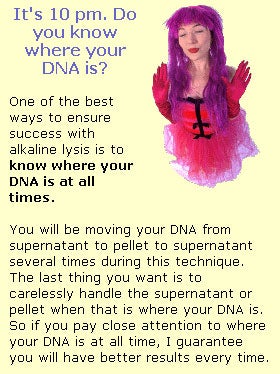Alkaline Lysis
Alkaline lysis is the method of choice for isolating circular plasmid DNA, or even RNA, from bacterial cells. It is probably one of the most generally useful techniques because it is a fast, reliable and relatively clean way to obtain DNA from cells. If necessary, DNA from an alkaline lysis prep can be further purified.
Alkaline lysis depends on a unique property of plasmid DNA. It is able to rapidly anneal following denaturation. This is what allows the plasmid DNA to be separated from the bacterial chromosome.
Typically, you will grow E coli cells that contain the plasmid you want to isolate, then you will lyse the cells with alkali and extract the plasmid DNA. The cell debris is precipitated using SDS and potassium acetate. This is spun down, and the pellet is removed. Isopropanol is then used to precipitate the DNA from the supernatant, the supernatant is removed, and the DNA is resuspended in buffer (often TE). A mini prep usually yields 5-10 ug. This can be scaled up to a midi prep or a maxi prep, which will yield much larger amounts of DNA (or RNA).
Specific protocols for alkaline lysis differ widely from lab to lab, and even from scientist to scientist. The basic principles behind the procedure, however, are fairly uniform. Here they are:
 1. Spin down your cells. Your DNA is still in the cells, so it is in the pellet at this stage.
1. Spin down your cells. Your DNA is still in the cells, so it is in the pellet at this stage.
2. Discard the supernatant. Pieces of cell wall are released from the bacteria and are floating around in the supernatant. These cell wall pieces can inhibit enzyme action on your final DNA, so it is important to get rid of all of the supernatant and to even invert the tube and wipe the lip with a Kim-wipe or Q-tip.
3. Resuspend the cells in buffer (often Tris) and EDTA. EDTA chelates divalent metals (primarily magnesium and calcium). Removal of these cations destabilizes the cell membrane. It also inhibits DNases. Glucose should also be added to maintain osmolarity and prevent the buffer from bursting the cells.
4. Lyse the cells with sodium hydroxide (NaOH) and SDS. This highly alkaline solution gave rise to the name of this technique. Mix this by gentle inversion and incubate on ice for five minutes (but no longer, or your DNA will be irreversibly denatured). Three things happen during this stage:
a.SDS pops holes in the cell membranes. SDS (sodium dodecyl - lauryl sulfate) is a detergent found in many common items such as soap, shampoo and toothpaste.
b.NaOH loosens the cell walls and releases the plasmid DNA and sheared cellular DNA.
c.NaOH denaturesthe DNA. Cellular DNA becomes linearized and the strands are separated. Plasmid DNA is circular and remains topologically constrained.
5. Renature the plasmid DNA and get rid of the garbage. Add potassium acetate (KAc), which does three things:
a.CircularDNA is allowed to renature. Sheared cellular DNA remains denatured as single stranded DNA (ssDNA).
b.The ssDNAis precipitated, since large ssDNA molecules are insoluble in high salt.
c.Adding potassium acetate to the SDS forms KDS, which is insoluble. This will allow for the easy removal of the SDS from your plasmid DNA.
Now that you've made it easy to separate many of the contaminants, centrifuge to remove cell debris, KDS and cellular ssDNA. Your plasmid DNA is in the supernatant, while all of the garbage is in the pellet.
6. Precipitate the plasmid DNA by alcohol precipitation (ethanolor isopropanol) and a salt (such as ammonium acetate, lithiumchloride, sodium chloride or sodium acetate) and spin this down. DNA is negatively charged, so adding a salt masks the charges and allows DNA toprecipitate. This will place your DNA in the pellet.
7. Rinse the pellet—your plasmid DNA—in ice-cold 70% EtOH and air-dry for about 10 minutes to allow the EtOH to evaporate.
8. Resuspend your now clean DNA pellet in buffer (often Tris) and EDTA plus RNases to cleave any remaining RNA. Your DNA is now back in solution.
DNA of this purity is good for a number of uses, such as in vitrotranscription or translation or cutting with some enzymes. If you are sequencing or transforming this DNA into mammalian cells, you'll want to use additional purification techniques such as phenol extraction, Qiagen column purification, or silica-based purification.
Read more about: Mama Ji's Molecular Kitchen
Bibliographic details:
- Article: Alkaline Lysis
- Author(s): Dr. Biology
- Publisher: Arizona State University School of Life Sciences Ask A Biologist
- Site name: ASU - Ask A Biologist
- Date published:
- Date accessed:
- Link: https://askabiologist.asu.edu/alkaline-lysis
APA Style
Dr. Biology. (). Alkaline Lysis. ASU - Ask A Biologist. Retrieved from https://askabiologist.asu.edu/alkaline-lysis
Chicago Manual of Style
Dr. Biology. "Alkaline Lysis". ASU - Ask A Biologist. . https://askabiologist.asu.edu/alkaline-lysis
Dr. Biology. "Alkaline Lysis". ASU - Ask A Biologist. . ASU - Ask A Biologist, Web. https://askabiologist.asu.edu/alkaline-lysis
MLA 2017 Style
Be Part of
Ask A Biologist
By volunteering, or simply sending us feedback on the site. Scientists, teachers, writers, illustrators, and translators are all important to the program. If you are interested in helping with the website we have a Volunteers page to get the process started.


